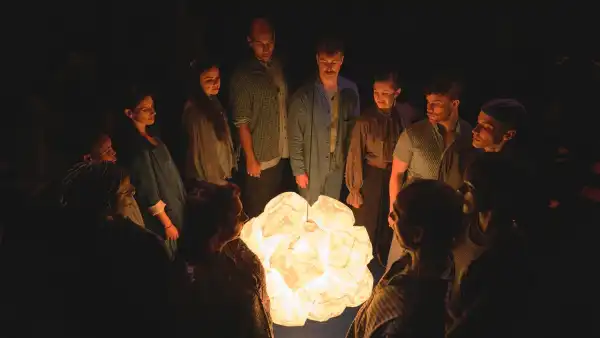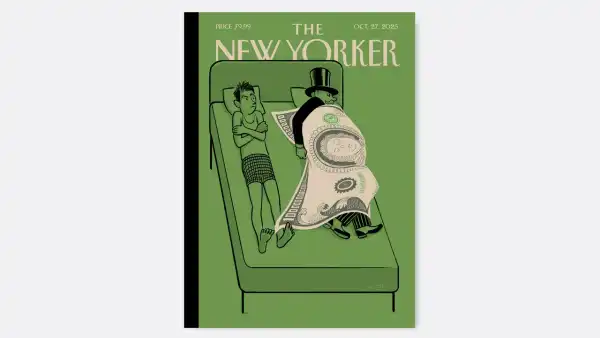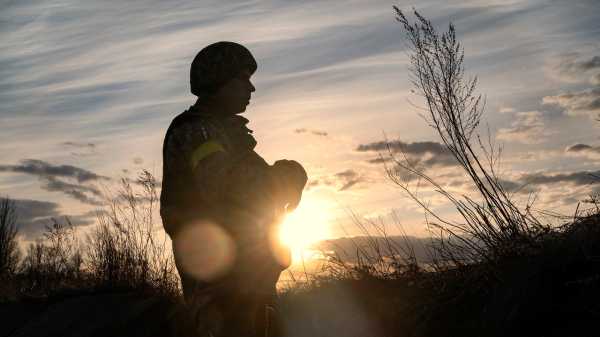
Maksym Levin, a Ukrainian photojournalist in his early forties, woke just before nine at a military base outside Kyiv. It was Sunday, March 13, 2022, the eighteenth day of war. The morning was overcast, and a light snow coated the ground. Russian troops had advanced within fifteen miles of the capital. Levin checked his phone. His girlfriend, Zoriana Stelmakh, had texted an hour and a half earlier: “Good morning, kitten.”
“Good morning,” Levin replied. “How are you?”
“I passed out last night. How about you, kitten? Did you sleep?”
“Yeah, same.”
Stelmakh had made Levin promise to check in every three hours whenever he was on assignment. Using an app on her phone and a tracking device installed in Levin’s Ford Maverick, she monitored his coördinates in real time.
“Heading out,” Levin texted. “I’ll be out of network.”
“Stay safe ♡.”
Several days earlier, Levin had lost a camera drone in a pine forest north of Kyiv. Before the battery died, the drone had sent some low-resolution footage that appeared to show surface-to-air missile systems. He was certain the drone had picked up Russian positions. Levin was a journalist through and through, but he was a Ukrainian first and had no scruples about sharing strategically useful images with the soldiers whose lives he had been documenting. “You should not forget that you are a human being,” he once told a room full of professional journalists at a media symposium. “If there is a need, then help.”
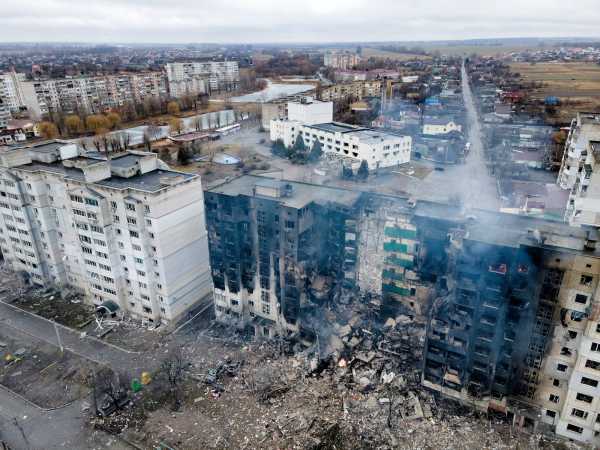
A residential building destroyed by Russian shelling, in Borodyanka, March, 2022.
A soldier named Oleksiy Chernyshov agreed to accompany Levin into the forest to recover the device. They had known each other since 2013, when Chernyshov was a photographer shooting protests on Maidan alongside Levin. Dressed in military fatigues and cradling an AK-74, Chernyshov took the passenger seat. Levin fastened a blue armband to his black jacket, signalling to any Ukrainian soldiers they might encounter that he was a “friendly.” He also packed a Swiss Army knife, a helmet, a bulletproof vest, and a headlamp; in the car, he kept a jerrican of gasoline.
At 12:51 P.M., Stelmakh could see Levin and Chernyshov travelling west on a country road through the forest. They were driving at just under twenty miles per hour when the car came to a halt. Over the next six hours, Stelmakh sent Levin a flurry of texts. At 6:55 P.M., night was beginning to fall, and Levin’s G.P.S. tracker indicated that he was in the same spot in the forest—near Moshchun, a village on the banks of the Irpin River. “Kitten,” Stelmakh wrote. At eleven, she sent another heart emoji.
Valerii Zaluzhnyi, the commander-in-chief of Ukraine’s armed forces, had referred to Moshchun as a “gate for the enemy on the way to the capital.” Around the time that Levin went missing, Russian forces surrounded the village, subjecting it to intense bombing and shelling from the air. Two out of every three homes were destroyed. Almost all of its residents had fled; the few who remained were living out of their root cellars, coming up to ground level only to scavenge for food. The commander of the brigade tasked with defending Moshchun, Oleksandr Vdovychenko, informed Zaluzhnyi that he didn’t have the “strength and means” to hold the village. One of his subordinates later told the Washington Post that in a single day “I felt like I got hit with a hammer on my head at least eight times, because everything was falling right next to us. . . . Many men couldn’t cope mentally.”
Stelmakh continued texting Levin every few hours. “Please be alive,” she wrote on March 15th. “Please don’t leave me.”
The next day, Levin’s phone picked up a signal in Moshchun. The G.P.S. indicated that his car was still in the forest.
In the late nineteen-seventies, Levin’s parents, Yevgeny and Valentina, moved from a city in southern Russia to a suburb of Kyiv. They already had a two-year-old son, Alexander, and after three years in Ukraine welcomed their second child, Maksym. “We were on the way to the hospital, and my parents still hadn’t decided on a name,” Alexander, now forty-six, told me recently. “I said, ‘Let’s call him ‘Maks.’ ” The family spoke Russian at home and visited the country often to see relatives, many of whom are still there.
When Levin was five years old, Yevgeny, an engineer, was transferred to Vietnam. The family lived in a Russian community there for two years before returning to Ukraine. Yevgeny often travelled for work. Several years later, on a trip to Poland, he bought Levin a rangefinder camera called the “Kyiv.” Levin had a friend whose father, a sports photographer, was always bringing home souvenirs from exotic places: Tokyo, Toronto. “I never wanted to be a war photographer,” Levin told the online magazine LensCulture, years later. “Travel the world, meet new people . . . that was the whole idea.” In his late teens, Levin enrolled in a university program in computer science, “to please my father.” After graduating, he pivoted back to photography, “probably more out of vanity than for the sake of peace in the world.”
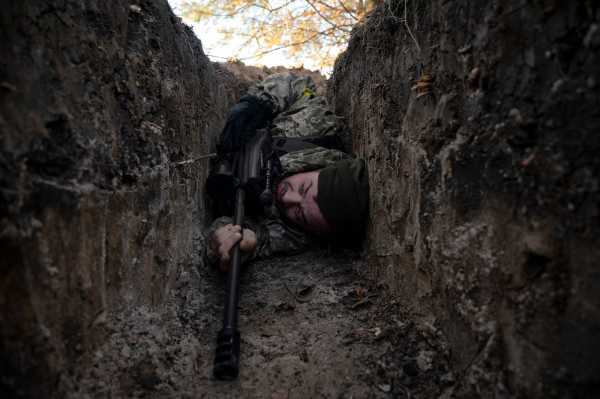
A Ukrainian soldier takes cover from a Russian helicopter air strike near Demydiv, March, 2022.
In 2014, Russian forces invaded Crimea and the Donbas, and Levin wanted to document the conflict there. Vanity seems to have remained his primary motivation. An old friend, the filmmaker Petro Tsymbal, told me, “When I asked him at the time why he was going to the front, he said ‘to become famous.’ ” But when Levin went to Luhansk and embedded with Ukrainian troops fighting Russia-backed separatists, he came to identify with the soldiers whose lives he was capturing. “It turns out I’m a sentimental person,” he later said. He contemplated enlisting in the army. “I am preparing for the possible escalation of the conflict,” he told an interviewer for Radio Liberty. He took courses in field combat and tactical medicine, before deciding that his comparative advantage lay in his ability to make a record of the war through photography. “I want to show that these are the people who protect all of us,” he said. He also wanted “to show other people that there’s war happening and it’s real.” Levin and Tsymbal would go on to collaborate on a documentary series called “Eighteen,” about eighteen-year-olds who died in the Donbas.
Five months after Russia annexed Crimea, Levin and three colleagues travelled to Ilovaisk, a town in Russian-occupied Donetsk. Along with some twelve hundred Ukrainian troops, they found themselves encircled by twice as many combatants from the Russian armed forces and the Donbas People’s Militia. “We believed that the presence of journalists would help the fighters in Ilovaisk,” Levin said, on a Ukrainian podcast, two years later. It didn’t. Nearly four hundred Ukrainian soldiers were slaughtered in the Ilovaisk “mousetrap,” as a battalion commander called it. “There were moments where I couldn’t take a picture,” Levin recalled. “I put down my camera and helped carry the wounded and the dead.” Driving out of the city, through what was supposed to be a humanitarian corridor, Levin and his colleagues came under heavy fire.
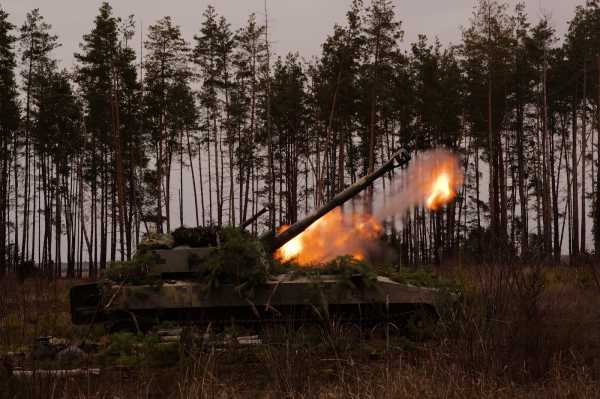
Ukrainian howitzers fire on a column of Russian armored vehicles moving toward Kyiv, March, 2022.
“Maks was driving very well,” Markiian Lyseiko, a friend and photojournalist, who had been in the passenger seat during the escape, told me. “He didn’t stop, because stopping the car meant death.” Levin caught up with a Ukrainian tank and tailgated it for protection. A few minutes later, a projectile hit the tank’s turret, sending debris hurling backward into Levin’s windshield. Shattered glass lacerated Levin’s right arm. “His eyes never left the road,” Lyseiko said. “He didn’t even know that he was injured, and I didn’t tell him, because he was driving.” After they made it to safety, Levin looked down and saw that his right pant leg was splattered in his own blood.
In an essay published days after their escape, Levin wrote, “I am ashamed that we got out of that hell and our friends didn’t. For the last two days, I can’t find a place for myself: I wonder if it could have been different, or if we could have taken someone else in the car with us and saved him. . . . My conscience is tormenting me for this.” Two months later, a close friend of Levin’s named Viktor Hurniak, a twenty-seven-year-old former freelance photojournalist who had enlisted, was killed by a Russian mortar. “When I realized that he was gone, that I will no longer cross paths with him, neither in Kyiv nor at the front, that’s when it got personal for me,” Levin told Ukraine’s Channel 24. Together with Lyseiko and Tsymbal, Levin produced an oral history of the battle, “After Ilovaisk,” based on testimonies from dozens of participants.
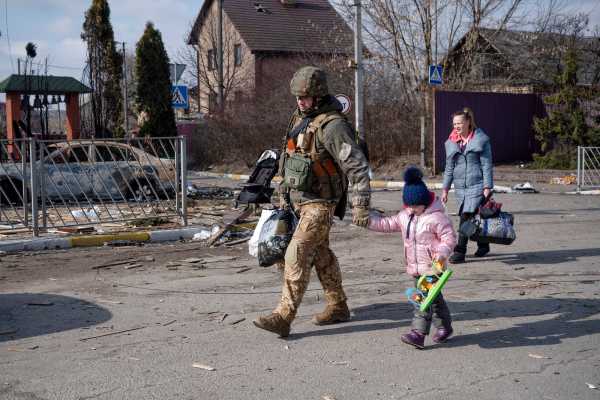
Residents flee Romanivka, March, 2022.
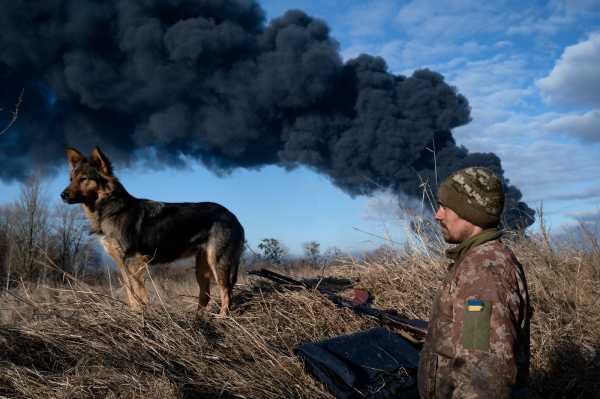
Smoke rises from an oil depot struck by a Russian rocket at the Vasylkiv airbase, February, 2022.
By his late thirties, Levin had been married and divorced twice. He had four sons, aged one to eleven. His first wife, Valentyna Kuzyk, told me, “Maks’s mother was always saying, ‘Why don’t you say something to Maks so he stops going to the front line? You have kids—you have to stop him somehow.’ ” As a journalist, Kuzyk said, “Maks never stopped, never said, ‘Well, that’s good enough.’ I didn’t expect my husband to just sit at home all the time, taking care of kids. If you marry a fireman, you don’t expect him to be with you every evening.” Their marriage collapsed in dramatic fashion, and Levin and Kuzyk were embroiled in a drawn-out custody battle for their three children. In his frustration, Levin started a men’s-rights organization to campaign against what he perceived as a bias against men in Ukrainian family courts.
Levin’s second wife, Inna Varenytsia, a freelancer for the Associated Press who had covered the Mosul offensive, in Iraq, told me, “Maks was always working and working, and if he wasn’t, he felt guilty.” He was also principled in the extreme. The couple never exchanged wedding rings. “He believed it was a safety measure, because the reflection could compromise a military position,” Varenytsia said. “But, also, he was just against fancy jewelry.”
Petro Tsymbal, the documentary filmmaker, said, “Maks was a non-compromising person. He could never close his mouth, and the words he used were very strong, like a blade.” Levin’s brother Alexander told me, “You couldn’t persuade him of anything once he had his mind made up.” The brothers scrupulously avoided certain subjects. “He’d come around, show his photographs, but we never talked politics,” Alexander said. Their father, Yevgeny, who had lived in Ukraine for four decades, still held a deep affinity for his native Russia. Levin recalled in an interview that his father had repeatedly denied the presence of Russian forces in eastern Ukraine: “He’d say, ‘Putin is a great guy,’ and I’d tell him, ‘Listen, the Russians shot our soldiers in the back in Ilovaisk. I was there.’ ” (Yevgeny told me that he didn’t remember this exchange, but said that he and Levin had their disagreements: “He had his point of view and I had mine.”)
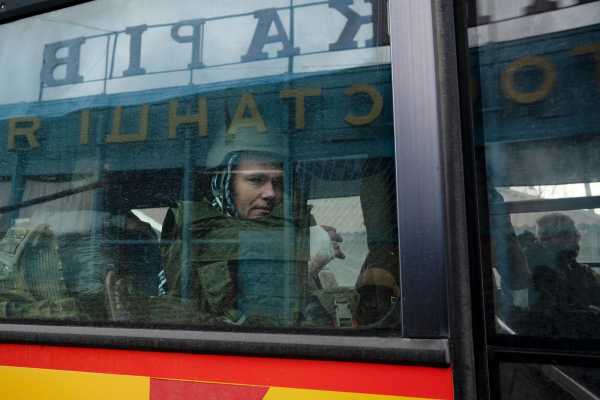
A wounded Ukrainian soldier is evacuated from Makariv, March, 2022.
Levin eventually regained joint custody of his children from his first marriage. When he wasn’t travelling, he spent almost every morning with them. He’d wake up early, drive from his home in Kyiv to the suburbs, make the kids breakfast, and walk them to school. Between assignments, he was building a treehouse. A couple of weeks before the war, he and Stelmakh took the boys on a three-day snowboarding trip in the Carpathian Mountains. “I think his children were the most important motivation for him,” Tsymbal told me. “They’re the reason he kept returning to the front.”
For the entire second week of the war, Alexander hadn’t been able to get through to his brother. Finally, Levin picked up.
“Maks, where did you disappear to?”
“I didn’t disappear. I’m where I’m supposed to be.”
“Where are you supposed to be?”
“I’m with the guys.”
“What guys? Where are you?”
“I can’t say where I am.”
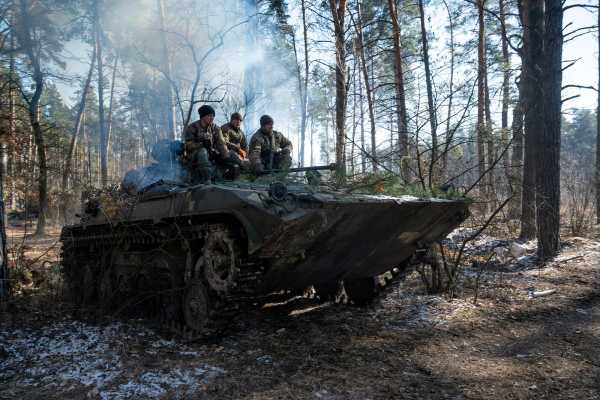
Ukrainian soldiers on a military vehicle near Demydiv, March, 2022.
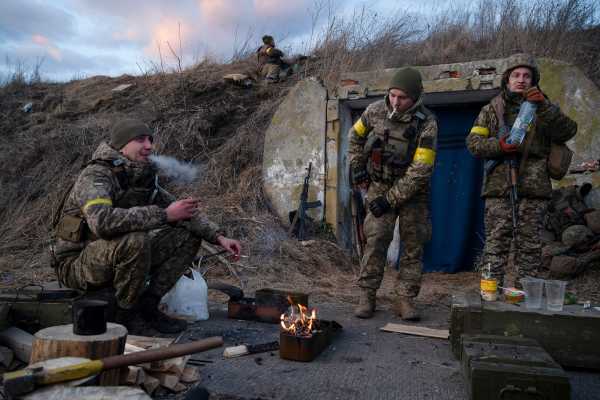
Ukrainian soldiers at the Vasylkiv airbase, February, 2022.
On April 1st, three Ukrainian police officers discovered Levin’s body in the forest. He’d been shot in the chest and the head. A bullet was lodged six inches in the dirt beneath him; he was likely already on the ground when his assailant pulled the trigger, at close range. The car, some fifty feet away, had fourteen bullet impacts and was completely burned out. A gasoline jerrican lay beside it, along with the charred remains of Oleksiy Chernyshov. The Ukrainian prosecutor general’s office issued a statement, finding that Levin had been “fatally shot twice with small-arms fire, by servicemen” of the Russian armed forces. According to an investigation by Reporters Without Borders, the men were “undoubtedly executed in cold blood, possibly after being tortured.” At the site of the killing, the Russians shared a meal, leaving behind packaging from their food rations, plastic spoons, cigarette packs, and instructions for firing rockets. Levin’s cell phone, helmet, flak jacket, and shoes were never found.
In my conversations with Levin’s family and friends, I kept hearing the same aphorism attributed to Levin, some version of “Every photographer dreams of making a photo that will stop a war.” He had said something to this effect in an interview with Radio Liberty, in 2015, and, in the circles he ran in, it took on the dimensions of myth, much like the apocryphal Zelensky quote “I need ammunition, not a ride.” In another interview, several years later, Levin had changed his tune: “If you think your photos will change the world—don’t be naïve.” He continued to shoot simply because he should. “It’s a kind of duty and responsibility,” he said. Then he added, “To be fully honest . . . I don’t know what it is for.” He seemed less interested in interrogating motives than in doing the work.
Levin had once attended a Reuters training on mental health for war correspondents. He later recalled, “Of course, the therapist told us that as professionals, we couldn’t take it personally. If we did, we just wouldn’t be able to survive for that long.” That didn’t make any sense to Levin. “I have biases, I have empathy for my heroes,” he said. “I am very connected with all those people. . . . War is a very personal thing.”
In 2019, in a television interview, Levin referred to the soldiers he embedded with as his “friends.” He recalled being woken one night in the Donbas by munitions bursting outside their windows. “After a night like that, they understood that we did not just come to make money off them,” he said. “We shared their risks, their lives—everything. We were with them through it all. Many friends we met died there.” Christopher Miller, a longtime American Ukraine correspondent who knew Levin, told me, “I could just see that the soldiers immediately opened up to him. He knew the lingo. He knew how to carry himself better than any of us. Just being with him signalled to the soldiers that you were somebody worth talking to.”
Not long before the war, Levin reconciled with his father. They had been planning a trip together to Uzbekistan, where the family has relatives. “I can’t say anything bad about my son,” Yevgeny told me. “He was a protector of Ukraine.” He had tried for years to persuade Levin to stay out of the war, not for reasons of ideology so much as personal safety. Levin’s brother said, “Our father still thinks it’s his fault. I tell him, ‘You can’t blame yourself—he was a grown man.’ ” Recently, Alexander was helping his mother around the house when he found a dust-coated plastic bin that looked like it hadn’t been opened in decades. Inside, he found Levin’s rangefinder, the one his dad brought back from Poland. His eyes welled up. “It’s the most precious thing I own,” he said.
Last April, President Volodymyr Zelensky honored Levin with a posthumous Order for Courage. According to the Committee to Protect Journalists, he was one of at least ten journalists killed in the first month of the war. Stelmakh collected twenty-five of Levin’s final photographs, from the Battle of Kyiv, and sent them to the Ukrainian Museum in New York City, where they are on view through March 5th.
Levin’s funeral was held at St. Michael’s Cathedral, the golden-domed monastery that President Biden toured with Zelensky earlier this week. He was buried in a vyshyvanka, a traditional Ukrainian embroidered shirt, which Stelmakh had got him as a gift a few months before he died. “Is this for our wedding?” he had asked. Metropolitan Epiphanius, the head of the Orthodox Church of Ukraine, presided over the service. Standing before Levin’s open casket, he said, “One of the best photographers of modern Ukraine, Maksym Levin did not just work as a journalist. He really served, served something that is higher than the present, that concerns eternity. He served the truth, so in his own way, because of the talent given to him, he served God.”
Eight years earlier, in the essay he published days after escaping the Battle of Ilovaisk, Levin had written, “You know, I don’t believe in God. Because if he existed, he would have saved the best. And the best ones remained there, in the fields.” ♦
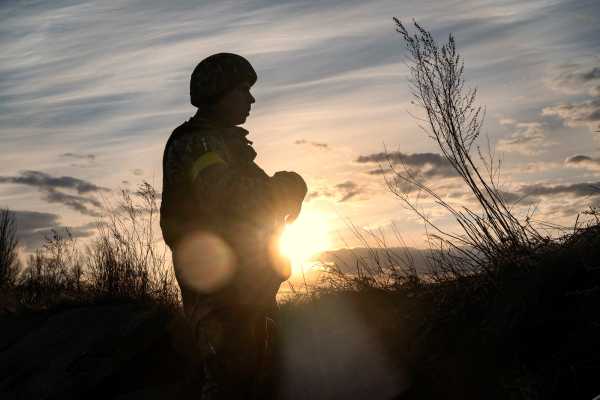
A Ukrainian soldier at the Vasylkiv airbase, February, 2022.
Sourse: newyorker.com
